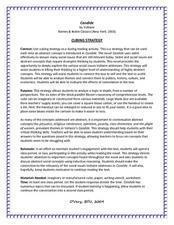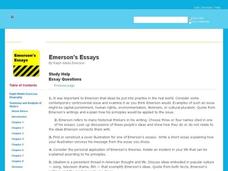Curated OER
Night: Annotated Bibliography
This annotated bibliography and list of websites are valuable resources for any study of the Holocaust and/or of Elie Wiesel's Night.
Curated OER
Modern American Theatre: Intro to Drama
Set this slideshow up at as an independent work station, or to provide your theater arts class with a look at the many manifestations of modern literary drama. Tennessee Williams, Edward Albee, and Arthur Miller are the focus of the...
National Endowment for the Humanities
Faulkner's As I Lay Dying: Form of a Funeral
Learners read and analyze William Faulkner's novel, 'As I Lay Dying.' They define Faulkner's place in American literary history, describe Faulkner's "South" in the context of the historical South and examine the Bundren family through...
Curated OER
"Zebra" by Chaim Potok
Combine art and literature to teach greater themes and symbolic meaning. Using the plan outlined in this resource, expose your class to the story "Zebra" by Chaim Potok, conduct discussions about social issues and nicknames, and ask...
Curated OER
Hemingway's Short Stories - Essay Questions
Ernest Hemingway is one of America's great writers. After reading one (or several) of his short stories, visit this list of 24 questions relating to at least 10 of his short stories. Some of the questions are basic recall questions, and...
Curated OER
Candide Cubing Strategy
Candide is a dense text. To assist in analyzing Voltaire's satire, groups employ a cubing strategy based on Bloom's taxonomy. Complete directions for the strategy, a template for the cube, a worksheet, and a topic list are included.
Curated OER
Ordinary People: Cubing Strategy
Readers of Ordinary People employ a cubing strategy based on Bloom’s Taxonomy to analyze, from multiple perspectives, an excerpt from Chapter 10 of Judith Guest’s novel. The excerpt, a rationale and complete directions for the activity...
Curated OER
Paradise Lost: Problem Situation
Let your class voice their opinions with a group debate activity. Before reading John Milton's Paradise Lost, they work in small groups in assigned roles to form a position about authority and rebellion, comparing a teenager's punishment...
Curated OER
The Boy in the Striped Pajamas: Questioning Strategy
Asking questions about the text is a great way for kids to become self-sufficient readers. Use the question-and-response strategy (QAR) to get them thinking about John Boyne's The Boy in the Striped Pajamas. After they read select...
Curated OER
The Grapes of Wrath: QAR--Question/Answer Relationship
Chapter nine of John Steinbeck's The Grapes of Wrath provides the text for an exercise that asks readers to think deeply about the items the Joads left behind and what these items might represent.
Shmoop
ELA.CCSS.ELA-Literacy.RL.9-10.5
Your students already know when they like a story and when they don't, but they may not know that the plots of these stories are shaping that opinion. Like all resources in this series, the two activities and quizzes provided here deal...
Curated OER
My Antonia: Cubing Strategy
What is love? Why is it important? Explore this concept with an interactive activity that brings together Bloom's taxonomy and Willa Cather's My Antonia. After completing the novel, pupils toss a Bloom's cube and then answer the...
Novelinks
The Adventures of Tom Sawyer: Cubing Strategy
The toss of a die determines what questions your pupils will answer in this lesson. Learners respond to questions based on Bloom's taxonomy, discussing The Adventures of Tom Sawyer with classmates along the way. They finish by writing up...
Penguin Books
A Teacher’s Guide to the Signet Classics Edition of Mary Shelley ’s Frankenstein
Contrary to popular belief, the monster's name in Mary Shelley's Frankenstein is not Frankenstein. A teacher's guide for the novel helps readers make sense of key details in the text, define vocabulary words, and discuss prominent...
The New York Times
Teaching Orwell and '1984’ with the New York Times
Doublethink and alternate facts? Big Brother and Facebook? 1984 and 2019? Sales of 1984 have surged and so has the use of George Orwell's dystopian classic in classrooms. Whether new to teaching the novel or a seasoned veteran you'll...
Curated OER
Literary Terms for Sophomore English Vocabulary Assessment
Sophomores record the definitions and examples of a series of literary terms and then create their own example of the word. Designed as an assessment, the presentation could also be used as an introduction or as a review.
Novelinks
The Book Thief: Cubing Strategy
Whether used to review prior to a reading assessment or as a way to generate ideas for an essay, this activity is sure to encourage critical thinking about Markus Zusak's The Book Thief. Kids create a six-sided question cube with each...
Curated OER
Classical Mythological Monsters
Students, after researching and analyzing ancient Greek and Roman mythological monsters, create a monster of their own similar to one they've researched or studied in their class syllabus. In addition, they present their creations to the...
Curated OER
Hamlet and the Elizabethan Revenge Ethic in Text and Film
Students discover how Shakespeare's play interprets Elizabethan attitudes toward revenge, as reflected in the structure of the Elizabethan revenge tragedy, one of the most popular forms of drama of that era. Students perform certain...
Curated OER
WHY IS LEONTES JEALOUS? FINDING A CAUSE IN THE WINTER'S TALE
Students examine several possible ways of understanding Leontes' jealousy through close reading, a performance activity, and the use of a primary source document. They, in groups, perform a scene.
National Endowment for the Humanities
Seeing Sense in Photographs & Poems
Learners analyze photographs and poetry as forms of each other. In this poetry and photography analysis lesson, young scholars use the photographs of Alfred Stieglitz and poetry from William Carlos William to explore how poetry and...
Curated OER
William Shakespeare's 'A Midsummer Night's Dream': Conflict Resolution and Happy Endings
Students analyze the characters and conflicts in Shakespeare's 'A Midsummer Night's Dream. In this conflict resolution lesson, students read the play and track the character actions with the specific plots. Students then predict endings...
Curated OER
The Great Gatsby: Primary Sources from the Roaring Twenties
High schoolers research the Roaring Twenties. In this 1920's America lesson, students analyze primary sources to develop an understanding of lifestyles and values of the era as they read F. Scott Fitzgerald's The Great Gatsby.
Curated OER
Emerson's Essays - Essay Questions
In this literature worksheet, students respond to 12 short answer and essay questions about Emerson's Essays. Students may also link to an online interactive quiz on the novel at the bottom of the page.
Other popular searches
- Parallel Lines
- Geometry Shape Parallelogram
- Parallel Structure
- Parallelograms
- Parallel Sentence Structure
- Series and Parallel Circuits
- Area of a Parallelogram
- Area Parallelogram
- Applied Math Parallel
- Area of Parallelograms
- Parallel Circuits
- Properties of Parallelograms

























